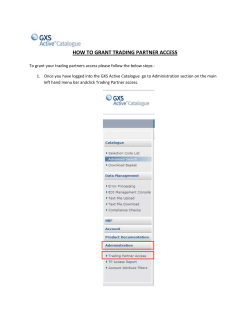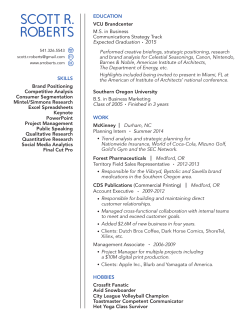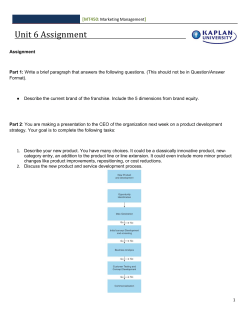
Influence of Retailer Equity on Shoppersââ¬â¢ Intention to Purchase
International Conference on Trends in Economics, Humanities and Management (ICTEHM'15) March 27-28, 2015 Singapore Influence of Retailer Equity on Shoppers’ Intention to Purchase Private Labels: An Empirical Evidence from Indian Large Retail Market Ramulu Bhukya, and Sapna Singh Abstract— The aim of this study is to analyze the influence of retailer equity on shoppers’ intention to purchase private labels from shoppers’ standpoint in the Indian large retailing. We conceptualize retailer equity comprises four dimensions-retailer awareness, retailer associations, perceived retailer quality and retailer loyalty. We proceeded with mall intercept method and contacted shoppers with the structured questionnaire at the outlets of large Indian retailers. We obtained 254 valid and useable questionnaires wherein responses are recorded on Likert-type scale of 5 points, with 1 being strongly disagree and 5 strongly agree. Then, the analysis was carried out by Exploratory Factor Analysis (EFA), Confirmatory Factor Analysis (CFA) and Structural Equation Modelling (SEM). Findings of this study reveal that all the retailer equity dimensions i.e., retailer awareness, retailer associations, perceived retailer quality and retailer loyalty have the positive and significant influence on shoppers’ intention to purchase private labels. Based up on the results, it was found that retailer perceived quality was the most influential dimension. Hence, retailers should give considerable importance on retailer equity dimensions to increase market for their private labels. Thus, this study is of great interest for large retailers who wish to increase their private labels’ value proposition to the marketplace purchase decisions and considered as the most important concept in business and academic research (Kim, Kyung Hoon, et al. 2008) because a positive customer-based retailer equity can help retailers in many ways, for example, it generates greater revenue, lower the sourcing or manufacturing costs, and increases profits and it will boost the firm’s ability to command and charge higher and premium prices, and ultimately success of brand extensions (Keller, 2003). Hence, understanding the customer based brand equity will help brand managers in gaining competitive advantage over competitor brands and make wise management decisions. The need for convincing evidence of brand-based equity creation has led to the development of a wide range of different brand equity models. Thus, this study is aimed to analyze and examine the influence of the retailer equity on shoppers’ intention to purchase private labels. II. LITERATURE REVIEW AND CONCEPTUAL FRAMEWORK A. Retailer Equity Pappu and Quester (2006) defines, retailers equity is a multidimensional concept formed from brand awareness, brand associations, perceived quality, and brand loyalty. The brand equity of the retailer helps in increasing the private labels sale as the retailer becomes a brand in itself emphasizing the private labels also to be treated as a brand in the mind of the customer (Rastogi, D. P, 2013). Building retailer brand equity leads to consumers being willing to pay (Bello and Holbrook 1995), more favorable responses to marketing instruments (e.g., quality and price), and increasing revenue and profitability (Ailawadi and Keller 2004), and such equity is used by retail managers as a performance indicator (Pappu and Quester 2006). Thus it was conceptualized that retailer equity dimensions have positive and significant influence on shoppers’ intention to purchase private labels. Fig.1 shows the hypothesized conceptual model. Keywords— Retailer equity, private labels, private labels, retailer awareness, retailer associations, retailer perceived quality, retailer loyalty, structural equation modelling, India. I. INTRODUCTION I N recent years, with the emergence of private labels concept, retailers are making considerable effort to increase their customer based brand equity by engaging in various brand management activities. For example, retailers offer the market differential value with a view to stimulate customer loyalty and so on. Building retailer equity increases revenue and profitability by insulating retailers from competitors. Moreover, with the assortment of consumer needs and wants, retailers have been forced to create various sustainable competitive tactics. For this, retailers must have a good understanding of brand equity from the consumers’ perspective (Taskin and Akat, 2010). Customer based retailer equity plays a strategic role in determining customers’ Ramulu Bhukya is a PhD Student at School of Management Studies, University of Hyderabad, India-500046 Dr. Sapna Singh is an Associate Professor at School of Management Studies, University of Hyderabad, India-500046. http://dx.doi.org/10.15242/ICEHM.ED0315023 27 International Conference on Trends in Economics, Humanities and Management (ICTEHM'15) March 27-28, 2015 Singapore D. Retailer Perceived quality This is another important dimension of brand equity (Aaker, 1991) and core facet across customer based brand equity frameworks (Aaker, 1996; Dyson et al., 1996; Farquhar, 1989; Keller, 1993; Netemeyer et al., 2004). Perceived quality is not the actual quality of the product but the consumer’s subjective evaluation of the product (Zeithaml, 1988, p. 3). Perceived means that the customers decide upon the level of quality, not the company (Ogenyi omar, 2009). Similar to brand associations, perceived quality also provides value to consumers by providing them with a reason to buy and by differentiating the brand from competing brands. Brand benefit clarity itself is not sufficient for the creation and management of a strong brand, as the buyer's positive or negative perception of a brand's quality needs to be measured (Burmann et al., 2009). Knowing how to perceive quality by consumers can provide important advantages for businesses. Thus, it was assumed that, strong perceived retailer quality form the higher retailer equity and the following hypothesis is formulated: Fig. 1 Conceptual Model B. Retailer awareness Brand awareness is the first and important component of brand equity (Aaker, 1991; Keller, 1993), it plays a significant role on purchase intention because consumers incline to buy a familiar and well known product (Keller, 1993; Macdonald, E. K., & Sharp, B. M., 2000). According to Keller (1993), brand awareness consists of two sub-dimensions: brand recall and recognition. Brand recognition is the basic first step in the task of brand communication, whereby a firm communicates the product’s attributes until a brand name is established with which to associate them. Brand awareness will help consumers to identify a brand from its competitors and make decision to purchase (Percy, L., & Rossiter, J. R. (1992). Likewise, if a brand with higher brand awareness will have a greater market share and a superior quality estimation (Grewal, et al., 1998) and it will be the same instance with retailer brand. Hence, it was assumed that a retailer brand with higher brand awareness will have greater influence on shoppers’ intention to purchase private labels. Thus the following hypothesis is developed: H3: Perceived Retailer quality has positive and significant effect on shoppers’ intention to purchase private labels. E. Retailer Loyalty Brand loyalty is the most important dimension of brand equity and it is what determined the best consumers purchase intention (David, A. Aaker., 1991; Jung, J., & Sung, E., 2008). Brand loyalty can be measured in two dimensions: affective loyalty and action loyalty. Affective loyalty is a specific brand preference from accumulative satisfaction to previous using experiences. However, affective loyalty just represents that a repurchase intention. According to Aaker (1991), brand loyalty adds considerable value to a brand and/or its firm because it provides a set of habitual buyers for a long period of time. Thus, it was assumed that, strong retailer loyalty form the higher retailer equity and the following hypothesis is formulated: H1: Retailer awareness has positive and significant effect on shoppers’ intention to purchase private labels. H4: Retailer loyalty has positive and significant effect on shoppers’ intention to purchase private labels. C. Retailer associations Brand associations are another important component of brand equity (Aaker, 1991; Keller, 1993) and a core part of Consumer Based Brand Equity (Romaniuk and Nenycz-Thiel, 2011). Aaker (1991) recommended that brand associations create positive attitudes and feelings among consumers and could provide them value by providing a reason for consumers to buy the brand. Brand associations are a key element in brand equity formation and management (Rio et al., 2001) and high brand equity implies that consumers have strong positive associations with respect to the brand (Atilgan et al., 2005). Customer based brand equity occurs when consumers have a high level of awareness and hold some strong, favorable, and unique brand associations in their memories (Tong, & Hawley, 2009). Thus, it was assumed that, strong retailer associations form the higher retailer equity and the following hypothesis is formulated: H2: Retailer association has positive and significant effect on shoppers’ intention to purchase private labels. http://dx.doi.org/10.15242/ICEHM.ED0315023 F. Purchase Intention Purchase intention is an important Concept in marketing (Morrison, 1979). Predicting purchases rest on the stage earlier than actual purchase, and is referred to as intention to purchase (Howard and Sheth, 1969, Kotler and Armstrong, 2012), it is a measure of the willingness to buy a product (Dodds, William B., and Grewal, D., 1991) and has also been operationalized as the probability that a consumer will buy a product or service (Kamins, M. A., and Marks, L. J., 1991). Brand equity dimensions have positive effect on consumers’ intention to purchase private labels (Lincoln, K., & Thomassen, L., 2008; Hsin et al. 2009; Macdonald, E. K., & Sharp, B. M., 2000; Ramulu and Sapna, 2014). III. METHODOLOGY To test the above conceptualized research hypotheses, a research framework was designed and conducted an empirical study on shoppers of large retailers in India. Mall intercept 28 International Conference on Trends in Economics, Humanities and Management (ICTEHM'15) March 27-28, 2015 Singapore method was employed to select the shoppers and collect their responses on conceptualized retailer equity dimensions, which were developed from Aaker’s consumer based brand equity framework. To collect the primary data, a research questionnaire was designed by including measurement items of consumer based brand equity scale (see the TABLE I) comprising of four exogenous constructs (retailer awareness, retailer , perceived retailer quality and retailer loyalty and an endogenous construct purchase intention, which were adopted from previous literature and extended to retail industry. Responses were recorded on 1 5-point Likert scale where 1= strongly disagree and 5= strongly agree. Total of 370 shoppers were requested to participate in the survey but only 254 agreed and filled the questionnaires, which is well above the critical sample size of 200 for developing structural equation models suggested by Hair et al., (2010). It shows 68 percent of response rate. Then, the analysis was carried out by employing structural equation modelling statistical technique on AMOS 21v. We followed the two-step approach recommended by Anderson and Gerbing (1988). In the first stage, the measurement model was analyzed to ensure sufficient reliability and validity of the constructs. In the second stage, the hypotheses of the relationships between constructs were tested. Model fit criteria followed in this study are recommended by Hair et al., (2010). limit. Where, Chi-Square = 225.12 and significant at 104 Degrees of freedom. Thus χ2/df = 2.164, Goodness of Fit Index (GFI) = .926 and Root Mean Square Error of Approx. (RMSEA) = .039. Similarly, the values of incremental fit measures were also found in the limit of acceptance. Where, Adjusted Goodness of Fit Index (AGFI) =.904, Normed Fit Index (NFI) =.948, Incremental Fit Index (IFI) =.950, Tucker– Lewis Index (TLI) =.953 and Comparative Fit Index (CFI) =.952. Loadings of all the factors were significant and in the range between 0.79 and 0.92, which were considered as good loadings and were shown in the TABLE I. D. Convergent and Discriminant validity Analyses Convergent validity tests the internal consistency of items within a construct. In other words, there should be strong correlation between items and corresponding construct and weak with the others. It was assessed by composite reliability (CR) and the average variance extracted (AVE). A convergent validity is said to be established when it follows two criteria. Firstly, the composite reliability of each factor should be greater than the average variance extracted by that factor (CR > AVE); secondly, the value of composite reliability of each factor should be more than 0.70 and the average variance extracted by that factor should be more than 0.50 (AVE > 0.50). The composite reliability of all the five constructs were between 0.79 and 0.91 and the AVE of each constructs were between 0.57 and 0.702 which were above the acceptable limit. Hence, all the five constructs followed convergent validity. Similarly, the discriminant validity of the scale can be evaluated by two methods, either inter-construct correlation matrix or based up on variance extracted method. In the first method, there should be weak correlation with other constructs and highest correlation with the same construct. This criteria was met for this study. On the other hand, Maximum Shared Squared Variance (MSV) of each construct should be lesser than Average Variance Extracted (AVE) of corresponding construct and similarly, Average Shared Squared Variance (ASV) should be lesser than Average Variance Extracted (AVE). This criteria was also met in this study. IV. RESULTS A. Demographic characteristics of the respondents This study included 254 valid questionnaires for the analysis. It comprises 76 percent of male (n = 193) and 38 percent of female (n = 96) respondents. Majority (78 percent) of the total respondents’ income level was above ₹ 20000. 45 percent (n = 114) of the total respondents possess graduation degree, 74 percent (n= 188) were in age group of 21-45 year. 36 percent (n=91) were the regular buyers. Thus the present study has the well composition of samples’ demographical characteristics. B. Reliability and validity analyses of measures In order to examine the internal consistency of the items, reliability of the scale used in the study was tested by using Cronbach’s’ alpha method for each dimension and overall together. Items with Cronbach’s’ coefficients more than 0.7 were retained for the study. Cronbach’s’ coefficients of all the five constructs were found between the range of 0.78 to 0.9 after deleting 1 items and finally 17 items were retained for the analysis of the study. E. Structural Model After obtaining convergent and discriminant validity besides achieving good model fit indices of measurement model, then moved further to test the hypothesized relationships of conceptual model by employing structural equation modelling (see the Fig. 2). It was observed that all the four dimensions constitute for 64 percent of total variance in purchase intention. C. Confirmatory Factor Analysis Confirmatory factor analysis (CFA) was performed for the five constructs in order to examine the convergent and discriminant validity of respective constructs by employing AMOS 21v. The values the model fit indices found within the acceptance limits suggested by Hu, L. T., & Bentler, P. M.,( 1999); Knile, (2005); Lia et al., (2007); Hair et al., (2010) ; Awwad and Agti ,( 2011). The values of absolute fit measures indices of measurement model were found in the acceptable http://dx.doi.org/10.15242/ICEHM.ED0315023 29 International Conference on Trends in Economics, Humanities and Management (ICTEHM'15) March 27-28, 2015 Singapore TABLE I RESULTS OF MEASUREMENT MODEL Construct and measures Retailer Awareness RAW1: Some characteristics of X come to my mind quickly RAW2: I can recognize X quickly among other competing brands RAW3: I am familiar with X brand Retailer Associations RAS1: X has very unique brand image, compared to competing brands RAS2: I respect and admire people who buy at X RAS3: I like the brand image of X RAS4: I like and trust the company, which makes X products Perceived retailer quality PRQ1: I trust the quality of products from X PRQ2: Products from X would be of very good quality PRQ3: Products from X offer excellent features Retailer Loyalty RL1: I would not buy other brands, if X is available at the store RL2: I consider myself to be loyal to X RL3: X would be my first choice Purchase Intention PI1: I like to purchase the private label products in the near future. PI2: I will recommend others to purchase Private label products. Loadings t-value P-value 0.920 0.904 0.899 21.475 19.852 -------- *** *** ----- 0.912 0.905 0.892 0.886 28.021 -------26.331 25.558 *** ---*** *** 0.885 0.824 0.806 16.025 -------15.049 *** ---*** 0.911 0.902 0.828 28.270 -------26.012 *** ---*** 0.838 12.625 *** 0.818 11.885 PI3: I will try to purchase private label products. 0.799 -------PI4: I Notes: X means the specific brand; ----- means the path parameter was fixed to 1, therefore, no t-value was given. Fig. 2 Structural Model http://dx.doi.org/10.15242/ICEHM.ED0315023 30 *** ----- International Conference on Trends in Economics, Humanities and Management (ICTEHM'15) March 27-28, 2015 Singapore TABLE II RESULTS OF STRUCTURAL MODEL AND HYPOTHESES TESTING [9] V. CONCLUSION AND DISCUSSIONS 5B [10] An attempt was made to analyze influence of retailer equity of shoppers’ intention to purchase private labels in the context of Indian retail industry. Aaker’s brand equity framework has been considered to measure the retailer equity. The findings of this study revealed that all the four retailer equity dimensions (i.e, retailer awareness, retailer associations, perceived retailer quality and retailer loyalty) have positive and significant impact on shoppers’ intention to purchase private labels. Thus, findings of this study were in line with the previous studies, such as B., and Grewal, D., 1991;Kamins, M. A., and Marks, L. J., 1991; Lincoln, K., & Thomassen, L., 2008; Hsin et al. 2009; Macdonald, E. K., & Sharp, B. M., 2000; Ramulu and Sapna , 2014). Based up on the findings of this study, it can be concluded that all the retailer equity elements have positive and significant effect on shoppers’ intention to private labels. Hence, findings of this study will be the great interest for the retailers, who wish to increase their brand equity with a view to increase market for their private labels, sale, and profits and so on. Thus, this study has theoretical and practical implications that benefit the research in several way, which related to brand equity and private labels. [11] [12] [13] [14] [15] [16] [17] REFERENCES [1] [2] [3] [4] [5] [6] [7] [8] [18] Aaker, David A. (1991), Managing Brand Equity. New York: The Free Press. Chaniotakis, I. E., Lymperopoulos, C., & Soureli, M. (2009). A research model for consumers’ intention of buying private label frozen vegetables. Journal of Food Products Marketing, 15(2), 152–163. http://dx.doi.org/10.1080/10454440802317006 Dick, A., Jain, A., & Richardson, P. (1995). Correlates of store brand proneness: some empirical observations. Journal of Product & Brand Management, 4(4), 15-22. http://dx.doi.org/10.1108/10610429510097663 Hair, J., Black, W., Babin, B., and Anderson, R. (2010). Multivariate data analysis (7th ed.): Prentice-Hall, Inc. Upper Saddle River, NJ, USA. Hsin Kuang Chi, H. R. Y., & Yang, Y. T. (2009, February). The impact of brand awareness on consumer purchase intention: The mediating effect of perceived quality and brand loyalty. The Journal of International Management Studies, 4(1), 135-144. Jaafar, S. N., & Lalp, P. E. (2012). Consumers’ Perceptions, Attitudes and Purchase Intention towards Private Label Food Products in Malaysia. Asian Journal of Business and Management Sciences, 8(2), 73-90. Jin, B., & Suh, Y. G. (2005). Integrating effect of consumer perception factors in predicting private brand purchase in a Korean discount store context. Journal of Consumer Marketing, 22(2), 62-71. http://dx.doi.org/10.1108/07363760510589226 Jung, J., & Sung, E. (2008). Consumer-based brand equity: Comparisons among Americans and South Koreans in the USA and South Koreans in Korea. Journal of Fashion Marketing and Management, 12(1), 24–35. http://dx.doi.org/10.1108/13612020810857925 http://dx.doi.org/10.15242/ICEHM.ED0315023 [19] [20] [21] Keller, K. L. (1993). Conceptualizing, measuring, and managing customer-based brand equity. The Journal of Marketing, 1-22. http://dx.doi.org/10.2307/1252054 Kim, K. H., Kim, K. S., Kim, D. Y., Kim, J. H., & Kang, S. H. (2008). Brand equity in hospital marketing. Journal of business research, 61(1), 75-82. http://dx.doi.org/10.1016/j.jbusres.2006.05.010 Lincoln, K., & Thomassen, L. (2008). Private label: turning the retail brand threat into your biggest opportunity. Kogan Page Publishers. Macdonald, E. K., & Sharp, B. M. (2000). Brand Awareness Effects on Consumer Decision Making for a Common, Repeat Purchase Product: A Replication. Journal of business research, 48(1), 5-15. http://dx.doi.org/10.1016/S0148-2963(98)00070-8 Pappu, R., Quester, P. G., & Cooksey, R. W. (2005). Consumer-based brand equity: improving the measurement–empirical evidence. Journal of Product & Brand Management, 14(3), 143-154. http://dx.doi.org/10.1108/10610420510601012 Pappu, R., & Quester, P. (2006). A consumer-based method for retailer equity measurement: results of an empirical study. Journal of Retailing and Consumer Services, 13(5), 317-329. http://dx.doi.org/10.1016/j.jretconser.2005.10.002 Ramulu, B., & Sapna, S. (2013). Consumers’ perception towards private label products of Indian retailers- a study on super markets in Hyderabad. International Journal of Business, Management & Social Sciences, Vol. II, Issue 12 (2), 94-99. Ramulu, B., & Sapna, S. (2014). An Analysis of Consumers’ Purchase Intention towards Private Labels of Indian Retailers. GE-International Journal of Management Research, Vol. II, Issue 8 (2), 343-360. Tong, X., & Hawley, J. M. (2009). Measuring customer-based brand equity: empirical evidence from the sportswear market in China. Journal of Product & Brand Management, 18(4), 262-271. http://dx.doi.org/10.1108/10610420910972783 Vazquez, R., Del Rio, A. B., & Iglesias, V. (2002). Consumer-based brand equity: development and validation of a measurement instrument. Journal of Marketing management, 18(1-2), 27-48. http://dx.doi.org/10.1362/0267257022775882 Yoo, B., Donthu, N., & Lee, S. (2000). An examination of selected marketing mix elements and brand equity. Journal of the Academy of Marketing Science, 28(2), 195-211. http://dx.doi.org/10.1177/0092070300282002 Yoo, B., & Donthu, N. (2001). Developing and validating a multidimensional consumer-based brand equity scale. Journal of business research, 52(1), 1-14. http://dx.doi.org/10.1016/S0148-2963(99)00098-3 Zeithaml, V.A. (1988), “Consumer perceptions of price, quality, and value: a means-end model and synthesis of evidence”, Journal of Marketing, Vol. 52 No. 3, pp. 2-22. http://dx.doi.org/10.2307/1251446 Ramulu Bhukya is a Doctoral Research Scholar in the School of Management Studies, University of Hyderabad, India. He holds an MBA degree in Marketing and Human Resource Management. He has industrial work experience in the field of marketing. His research papers are published in reputed peer reviewed international journals and presented research papers in several national and international conferences. His research areas of interest include Consumer Behavior, Brand Management, Brand Equity, and Private labels. 31
© Copyright 2025









